Operation Tailwind (Pt. 4): As NVA Hordes Close In SOG Pulls An Intel Coup
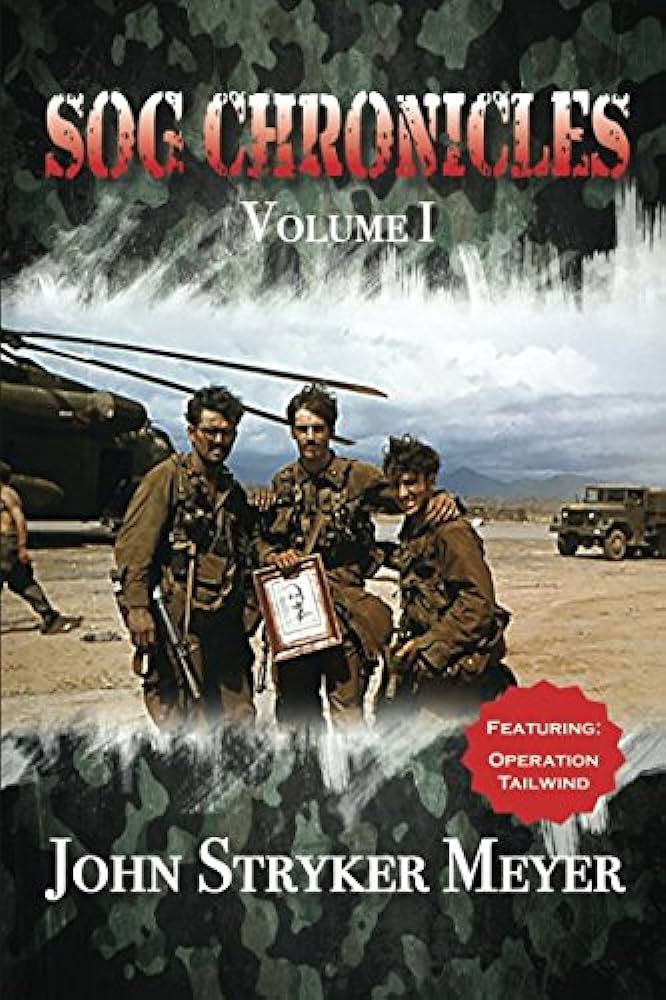
By John Stryker Meyer
From SOG Chronicles: Volume One, Chapter 4, pages 65-76, printed with permission
The morning of Operation Tailwind Day 4 dawned upon B Company Hatchet Force of MACV-SOG (SOG) moving toward an LZ to lift out the more seriously wounded among the remaining 127 men who could still walk. All 16 Green Berets had been wounded at least once, and about 40 Montagnard troops were wounded during the first three days of this secret foray deep into Laos to take pressure off of the CIA’s Operation Gauntlet in southern Laos on the Bolovens Plateau further west.
B Company Commanding Officer Capt. Gene McCarley had the point element moving toward an apparent clearing with one thought in mind: Get one Marine Corps heavy-lift CH-53D helicopter in to pick up the wounded and then continue to march, to destroy any NVA fortifications, supplies or troops they encountered. By now the entire 2nd Platoon was being used to help care for and transport the wounded under the tireless leadership of SF Medic Gary Mike Rose,—including three who were carried in impromptu stretchers.
On the previous day, when one CH-53D medevac was shot down by enemy gunners, B Company had strong support from the Marine Corps Cobra gunships of HML-367 (Scarface) in addition to 22 sorties by A-1 Skyraiders, eight sorties by Air Force F-4s from Ubon, Thailand, and Stinger and Spectre gunships working against enemy forces during the night. More than once that night, the transponders failed to provide a commo link to Stinger and Spectre, which meant McCarley had to direct their air strikes from white phosphorous grenade explosions or strobe lights held by B Company men—usually, they’d stick their strobe lights into the barrel of an 40mm M-79 grenade launcher. Instead of inserting a live round into the back of the barrel, the grenadier would crack the barrel open, insert the strobe light into the back side of the barrel, point it skyward toward the circling gunship and turn on the blinking light—which could be easily picked up by the Air Force crew member, who would in turn lock in their computers on that light and then make gun runs based off of that exact location. In 1970, at least two recon teams protected by Spectre at night had rounds brought to within 10 feet of the teams perimeter. That’s how accurate Spectre was then.
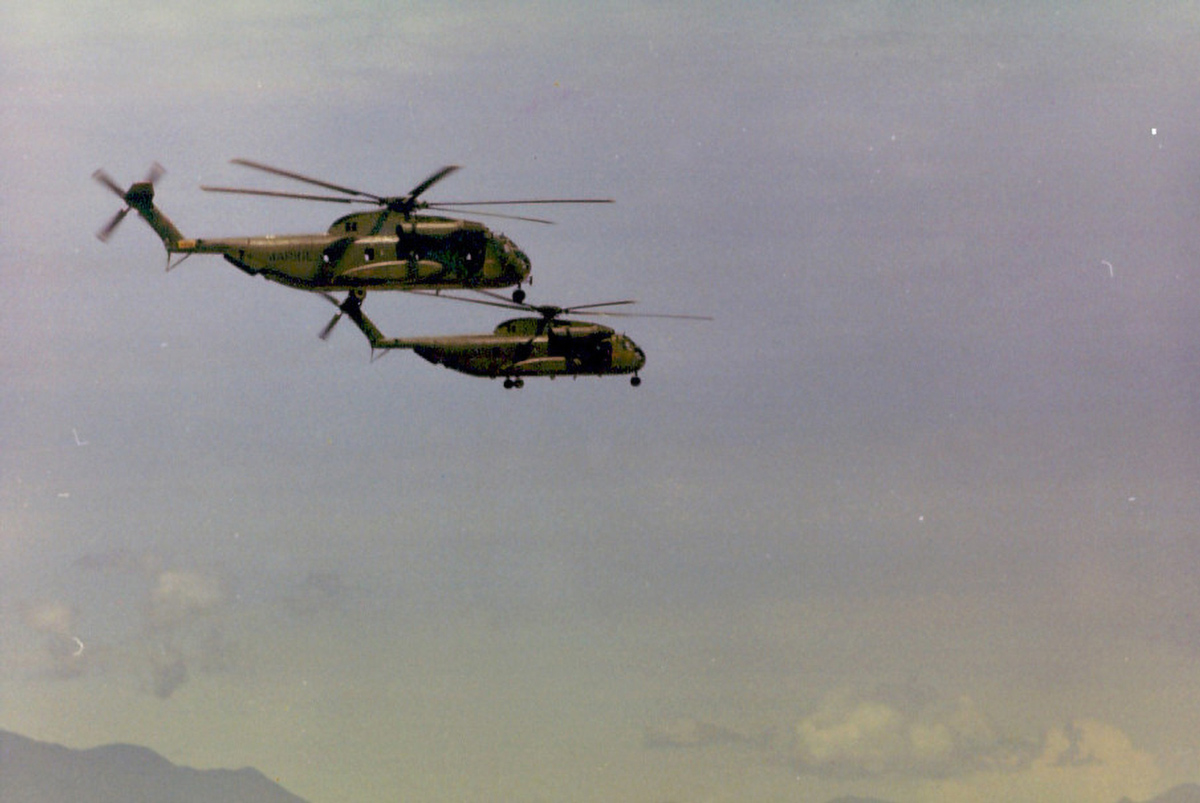
U.S. Marine Corps CH-53Ds from HMH-463 (Dimmers) head west toward Laos during Operation Tailwind in Sept. 1970. (Photo Courtesy of Larry Groah)
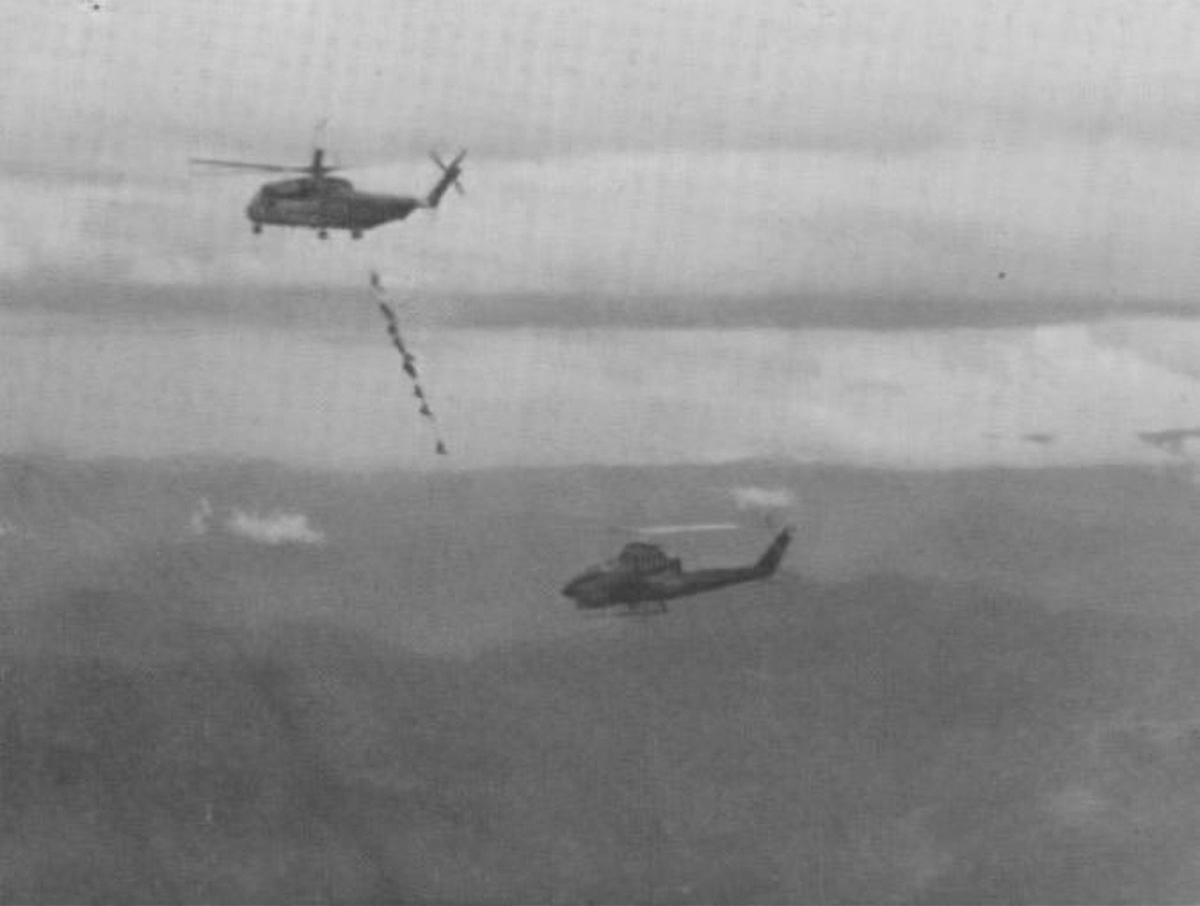
An HMH-463 heavy-lift Marine Corps helicopter, YH-20, heads east with Marine crew members and Green Beret medics SSG John “Doc” Padgett and Sgt. John Browne after a CH-53D had a crash-landed due to enemy gunfire and a B-40 rocket hitting it. A Marine Corps Cobra gunship from HML-367 Scarface is escorting the big chopper. (Photo Courtesy of Joe Driscoll)
The men on the ground didn’t know about two startling developments: The weather was closing in with a storm front that would prevent TAC AIR from supporting B Company and Operation Tailwind had rocked the NVA brass into rallying hordes of North Vietnamese and Pathet Lao troops that were moving toward the Highway 165 area near the tiny hamlet of Chavane.
“When we started (Day 4) we hadn’t thought about an extraction, except for getting the wounded out,” said McCarley. “We took our mission seriously: relieve the pressure on the CIA’s operation. Thanks to the TAC AIR we had hurt the enemy, no question, and by continuously moving, we had kept the NVA off balance. We were tired but our morale was good…We had been on the move about an hour when we heard dogs. These weren’t dogs that sounded like the tracker dogs the NVA used on us, they sounded like pet dogs. So we moved toward their sound and the 1st Platoon followed them.”
The dogs led B Company to what would become one of the greatest military intelligence coups of the eight-year SOG secret war in Laos.
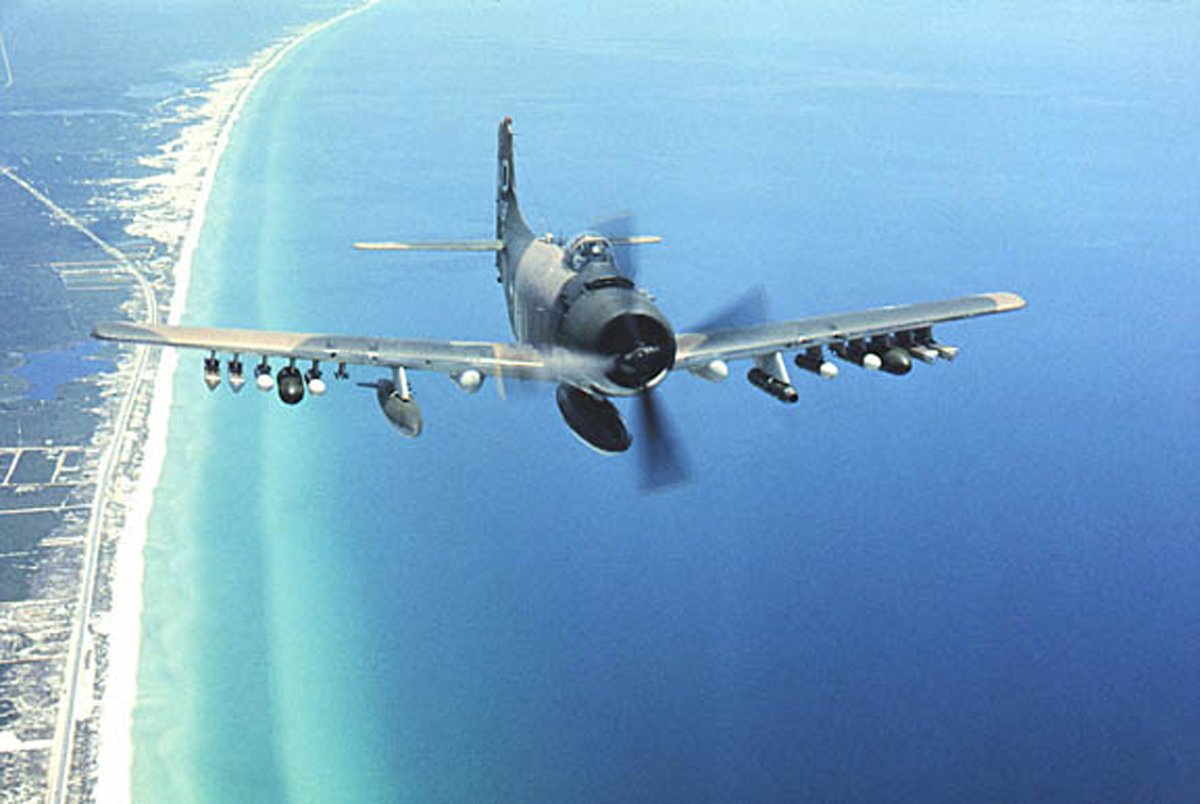
A fully armed A-1H Douglas Skyraider flying south along the beach in South Vietnam. This single-engine warbird could remain on station for several hours, providing support to troops such as the Green Berets during Operation Tailwind. During day four of the operation, there were several occasions when devastating gun runs and cluster bomb unit sorties by SPADs stopped enemy troops massing to attack the men of B Company. (Photo Courtesy of Joe Driscoll)
Before long, enemy troops fired several B-40 rockets at the point element of B Company and then fell back. “It looked like they (the NVA) had gone back to some sort of bunker complex, McCarley said. “After a brief skirmish and brilliantly executed SPAD gun runs, where they used Cluster Bomb Units (CBU) on enemy positions, the 1st Platoon lead the assault on those bunkers with a well-coordinated attack while 2nd Platoon covered our left flank and provided rear security. 3rd Platoon protected our right flank…we caught them napping. We hit the outpost when they were cooking breakfast. There were open fires, fires with cooking pots on them. Hell, they never had anyone mess with them before this deep into Laos.”
A few NVA hid in a couple of bunkers, whom the Montagnards quickly eliminated with hand grenades. “Those bunkers were nothing but gory blood and guts after the grenade attacks,” McCarley said. Again, A-1 Skyraiders delivered CBUs precisely along two key enemy lines, instantly silencing enemy gunfire, hand grenade and rocket attacks. In those CBU runs A-1 Skyraider pilots dropped CBU-25 bombs that consisted of a dispenser unit that held 665 tennis-ball-sized BLU-26 or BLU-36 fragmentation submunitions or bomblets. Once dropped from the Skyraider, the CBU-25 casing broke open in flight and released the individual bomblets that exploded on impact, or they could be set for air-burst or fixed-period delayed detonation. Within a short period of time, more than 70 NVA were killed as B Company swept through the base camp.
As B Company drove the remaining NVA out of the outpost, they discovered a bunker in the base camp that “appeared to be like a basement in a regular house,” said McCarley. It was at least 10 feet long and 10 feet wide “with maps on the walls and a foot locker loaded with documents. I emptied my rucksack of everything, except for the extra CAR-15 ammo. By that time, I had used the extra (radio) battery and C-4 that I was carrying and I started packing it with enemy documents, papers, code books, transportation logs.”
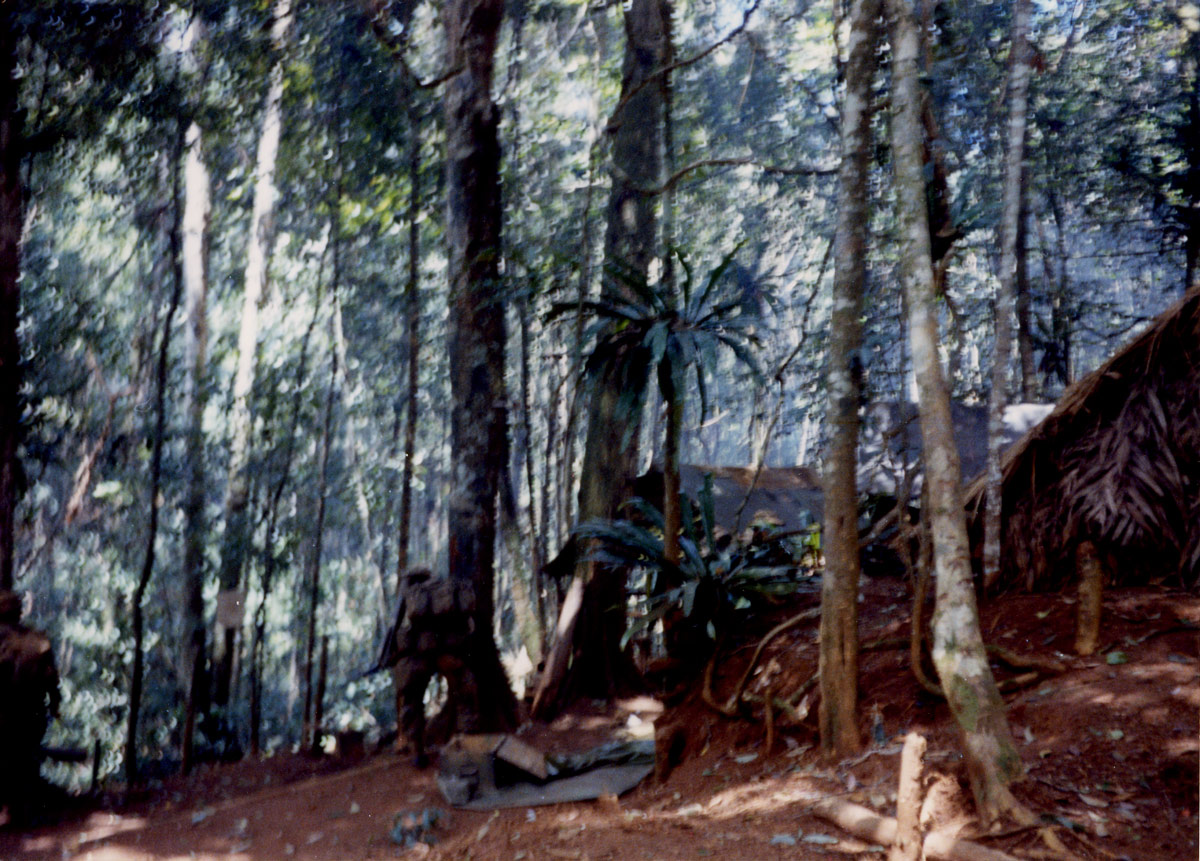
An unidentified Montagnard of SOG’s top secret B Company stands next to enemy caches in an enemy base camp deep inside Laos during Operation Tailwind in Sept., 1970. On the right are several of the enemy structures where SOG demolition experts and A-1 Douglas Skyraiders destroyed more than nine tons of rice, an 81mm mortar, and four trucks before escaping with a large amount of NVA documents, money, maps, and codebooks. (Photo Courtesy of Gene McCarley)
Within 15 minutes the base camp was overrun. The area was searched for intelligence and photographs were taken as medic Mike Rose continued to treat the wounded men of Company.
By now it was clear to B Company intelligence men that they had stumbled into an NVA battalion base camp that was a major logistical command center and probably the headquarters that controlled the nearby Laotian Highway 165. In addition McCarley’s haul also found more intelligence documents, papers, code books, transportation logs, records, North Vietnamese currency and photographs—including a photo of Ho Chi Minh—the head communist in N. Vietnam until he died in 1968.
Remaining true to his original operation order, McCarley had all of the intelligence documents packed and ordered B Company and all of its walking wounded to march out of the battalion base camp while demolitions experts wired a 120mm mortar, four enemy trucks and more than nine tons of rice for destruction. As usual, after the Special Forces charges exploded, A-1 Skyraiders followed up with gun, napalm and bombing runs to completely destroy all enemy structures and supplies.
Several weeks after Operation Tailwind, MACV-SOG headquarters informed McCarley that the base camp B Company attacked was a crucial station for the NVA’s 559th Transportation Group—the first, major NVA group formed by the Hanoi communist political leadership in May 1959. The 559th’s mission was to expand the Ho Chi Minh Trail in anticipation of future efforts to overrun the South Vietnamese and American assistance units. Author Richard H. Shultz, Jr., detailed the 559th’s formation in 1959 in his book The Secret War Against Hanoi. The 559 Transportation Group oversaw all troop and supply movement along the Ho Chi Minh Trail in addition to maintaining it and expanding the trails that weaved into South Vietnam. Any NVA soldier received a special award and bonus if he captured or killed a SOG operator.
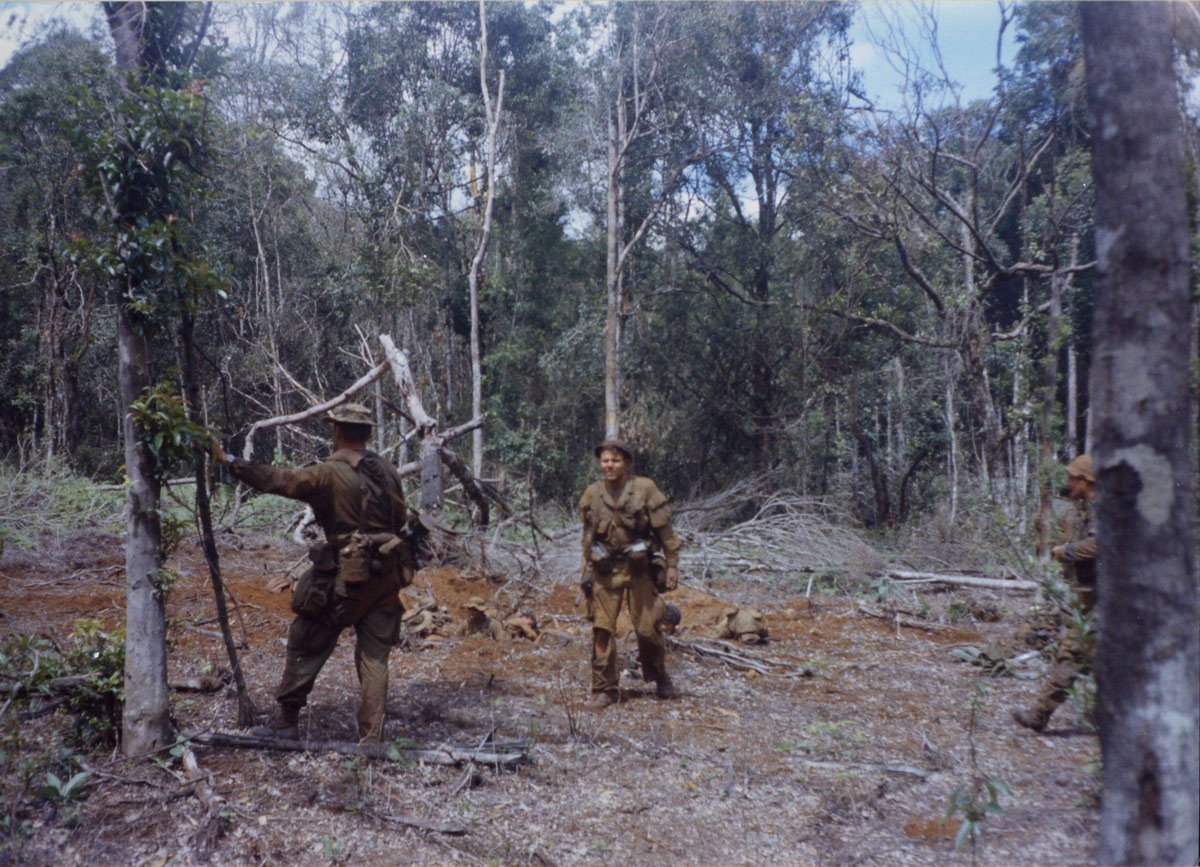
The only Green Beret medic on the Operation Tailwind Hatchet Force, Gary Mike Rose walks across an open area that the Special Forces men were clearing for an LZ to land a helicopter on day three of the operation in order to medivac the most seriously wounded men of Company B. (Photo Courtesy of Gene McCarley)
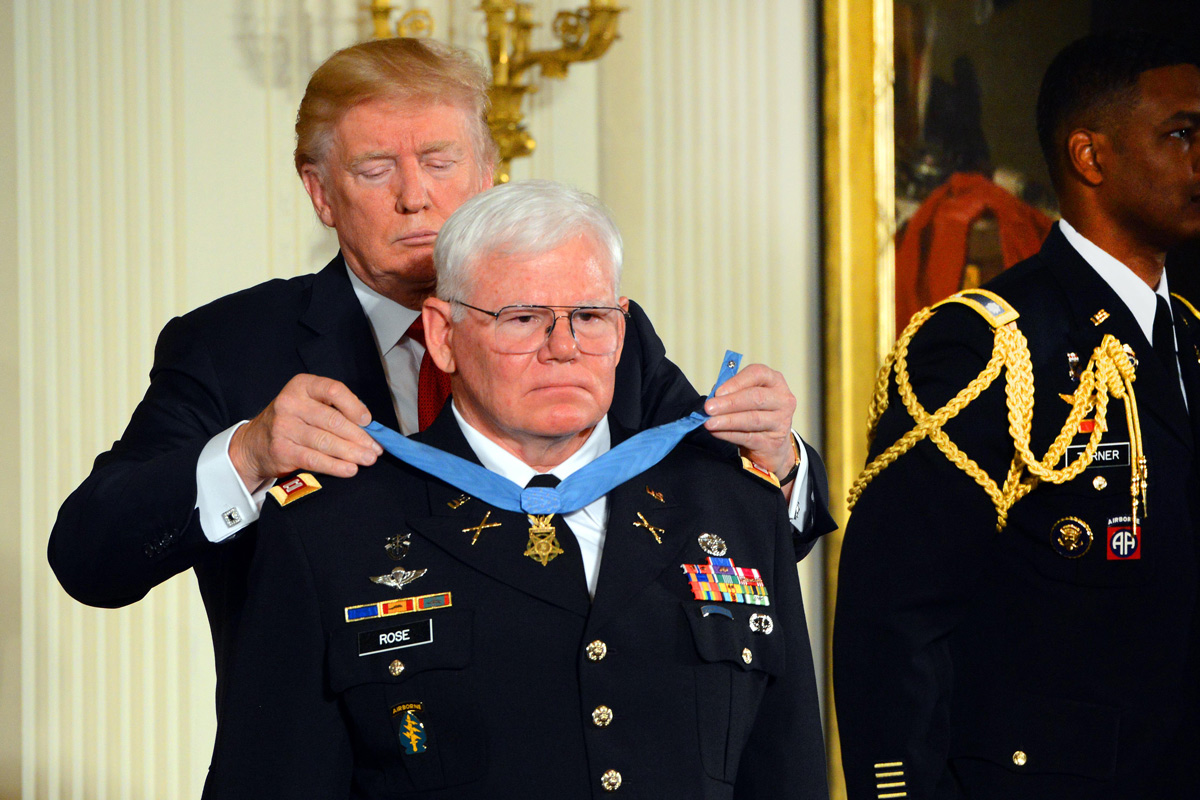
Captain Gary Michael Rose is credited with treating 60-70 wounded personnel and saving many lives. He was immediately nominated for the Medal of Honor, but due to the classified nature of the mission in Laos the award was downgraded to the Distinguished Service Cross. In 2016 then-Secretary of Defense Ash Carter approved the award upgrade. The requirement that the medal be awarded within five years of action was waived in 2017 and he was presented the award by President Donald J. Trump in a White House cermony on October 23, 2017. (Photo courtesy of the Department of Defense)
Weather and NVA hordes close in
Meanwhile, back at Kontum, all of the air assets, the A-1 Skyraiders of the Da Nang-based Operating Location Alpha Alpha, Scarface Cobra pilots and HMH-463 CH-53D pilots were getting a detailed briefing on the weather and a sighting by Covey of hundreds, if not more than 1,000 NVA and Pathet Lao troops moving east toward B Company. “During that final briefing it was very clear, today it was do or die,” said Scarface pilot Joe Driscoll. “The big thing was the stark seriousness of the moment. Everyone knew they had suffered heavy casualties and now the weather was closing in on them.” A-1 Skyraider Pilot Tom Stump added, “The weather was dog shit when we took off…I wasn’t optimistic about getting them out of there.”
On the ground in Laos, McCarley pressed forward until he received a “disturbing” radio call from Covey, sometime in the early afternoon of Sept. 14th, Day 4 of Operation Tailwind. “I believe it was Covey Rider Jimmy ‘War Daddy’ Hart radioed down and told us the NVA were massing and that if we didn’t get out of there today, we weren’t going to get out period. That got my attention. Frankly, he mentioned the weather issue too, which up to that point in time I wasn’t aware of because we were in the jungle.”
Realizing they needed an LZ large enough to handle a Marine Corps CH-53D, in light of losing one of the HMH-463’s heavy-lift helicopters on a tight LZ the previous day, McCarley moved down a road toward a clearing that was large enough for an LZ. However, the open area was seated too deeply in a valley, which had hills on two sides of it where NVA gunners would be able to have clear fields of fire on the Marine rescue helicopters as well as the supporting TAC AIR assets and Marine Corps “Scarface” Cobra gunships.
To facilitate the continued movement of B Company, A-1 SPADs and Scarface Cobras “gave us fire protection to the front and to the rear,” McCarley said. “The NVA kept hitting us with automatic fire and B-40s. The air strikes kept them back far enough so they couldn’t do any real damage.”
At some point, Covey ran dangerously low on fuel and returned to base and connected SPAD Pilot Tom Stump directly with McCarley about future air strikes, shortly before the first CH-53D arrived in the Area of Operations. “I’ll never forget it. When I spoke to Gene his voice was as calm as a man at a Sunday church picnic,” Stump said. “He had that slow southern draw and calmly said he was getting his ass kicked down there and all the while, I could hear gunfire down there, explosions from hand grenades…He said he needed separation between the company and the NVA. We were on station for two hours doing just that, providing close support…With all of the SF wounded and the large number of casualties they had I couldn’t see how we’d get them out.”
Providing that sort of support on that day, in that location, with the bad weather closing in while coping with smoke from previous bombing and napalm runs and CBU explosions was extremely challenging. Once Stump and his fellow pilots maneuvered below the low-hanging clouds, they had to be extremely aware of jagged buttes and irregular mountain formations in the area before dropping their ordnance. The CBU ordnance slowed down one faction of NVA that had several hundred men advancing toward B Company.
McCarley and his men were grateful for the close support of Stump, his fellow SPAD pilots, Scarface and TAC AIR, but Stump stood out in his mind. McCarley said, “Tom Stump flew so close to us during some of those gun runs I could tell if he had shaved or not. That’s just how close those A-1 Skyraiders flew in support of us. We were extremely grateful for all of the air support, believe me, but seeing Stump was something that stuck with me…I also think it’s safe to say that because this was a SOG mission deep into Laos, none of the air assets got the credit they should have received for the remarkable coverage they provided to us over four days, from the fast movers right down to Scarface and the Coveys.”
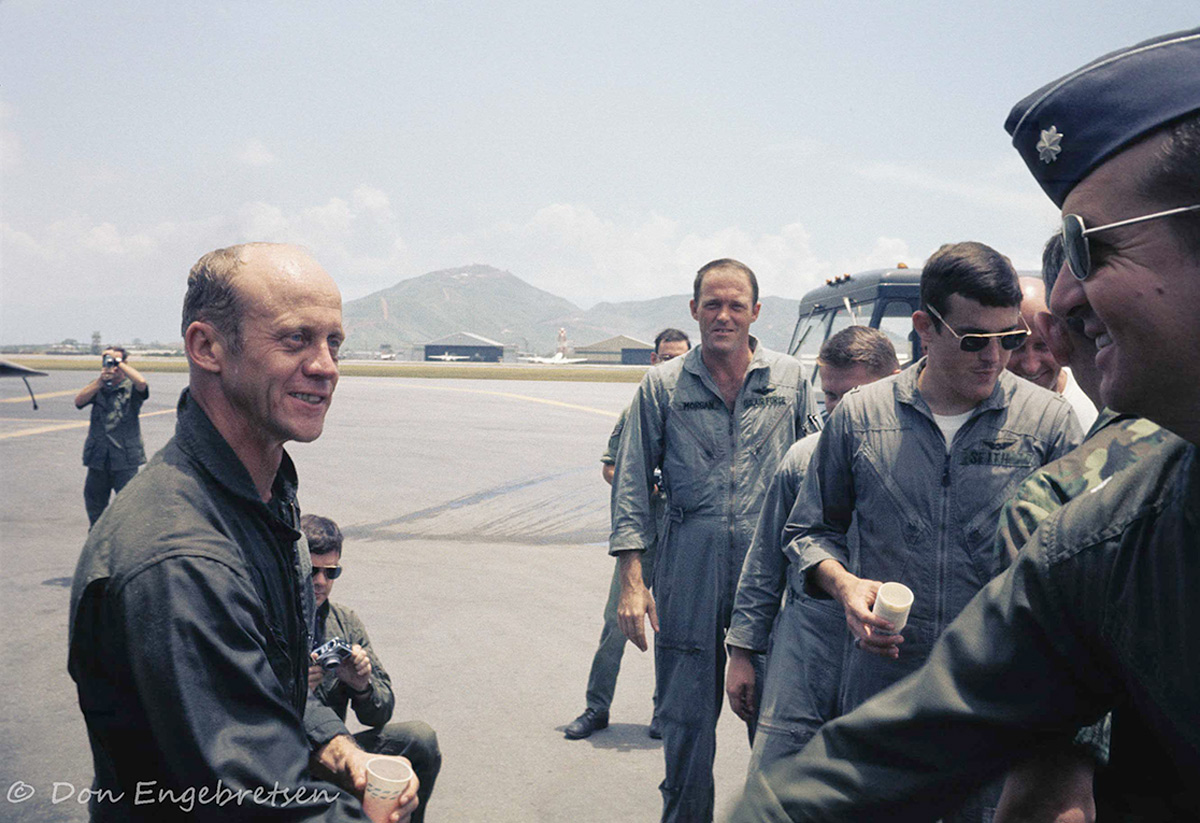
Air Force Lt. Col. Mel Swanson, right, was the commanding officer of the Da Nang-based 56th Special Operations Wing, Operating Location Alpha Alpha. Swanson flew close ground-support sorties with fellow SPAD pilots throughout the four-day Operation Tailwind in Laos. Here, he’s shaking the hand of Jim Wold, the first OLAA commander. (Photo Courtesy of Don Engebretsen)
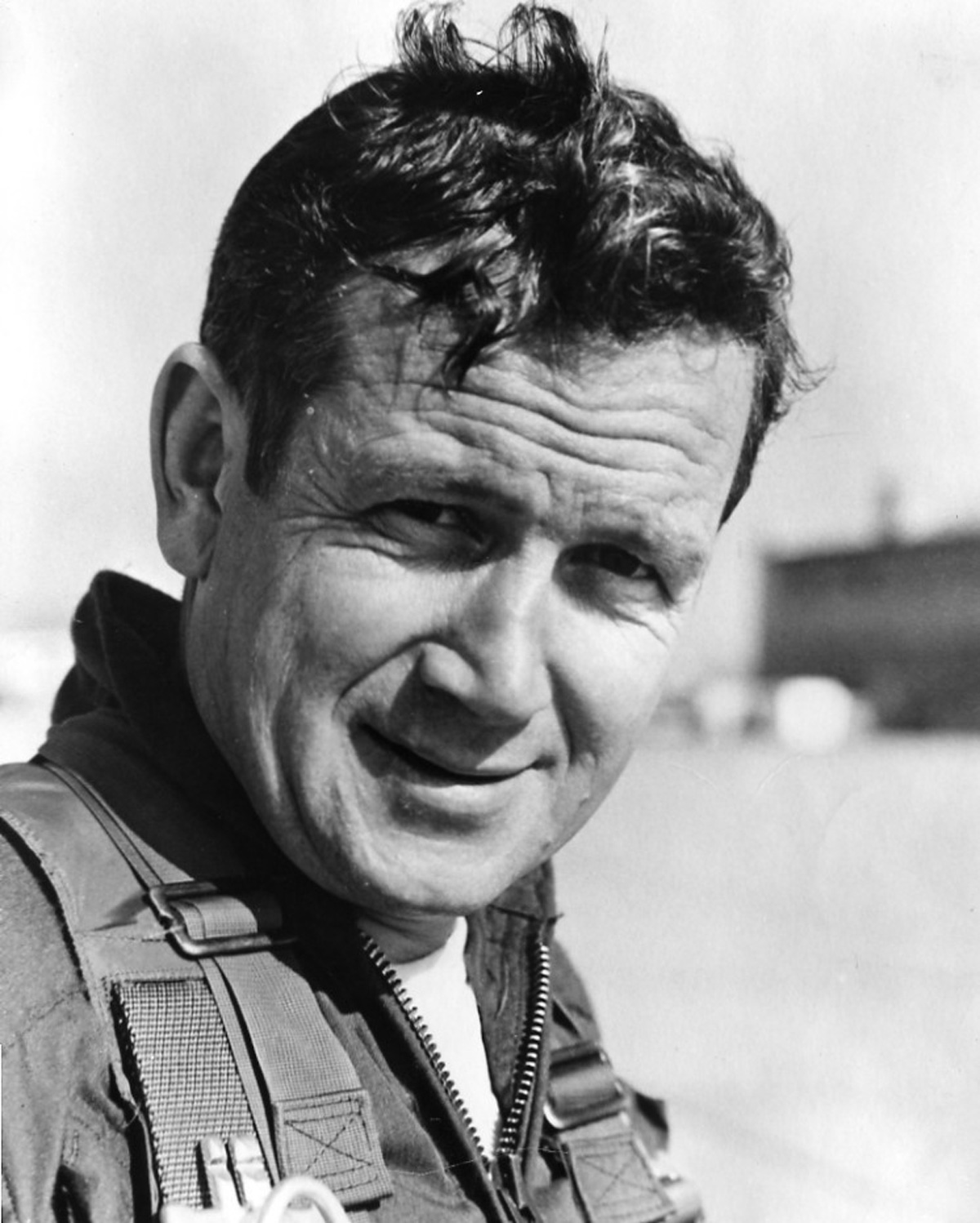
U.S. Marine Corps Lt. Col. Harry Sexton was the commanding officer of the Marines’ Cobra gunships that supported Operation Tailwind deep in Laos in September, 1970. The Cobras were assigned to HML-367, radio call sign Scarface, which flew in support of top secret SOG missions during most of the eight-year secret war. (Photo Courtesy of Joe Driscoll)
Scarface commanding officer Lt. Col. Harry Sexton and co-pilot Lt. Pat Owen provided the critical link between B Company and the air assets that were once again rallying around the beleaguered SOG Hatchet Force. When Covey returned to the Area of Operations, Sexton and Owen prepared an action plan to bring in the CH-53Ds to the LZ. For the veteran Scarface pilots, it was simply another deadly SOG mission into Laos.
B Company found a heavily traveled dirt road, only wide enough for foot traffic and headed to a second LZ, one that provided better cover and less exposure to enemy ground fire for the helicopters and for the men of B Company. As they moved, Covey Rider Jimmy ‘War Daddy’ Hart told spotted another “horde of NVA” moving toward B Company.
This time, Hart told B Company to put on their gas masks and directed A-1 sorties flown by Hobo 20 and Firefly 44 based in Thailand to deliver CBU-30 tear gas ordinance on the next “horde of NVA” while B Company found and secured a second LZ for the Marine CH-53Ds to land. This drastic tactic worked. It slowed down another NVA horde, but many of the men in B Company, including McCarley, Rose and others were hit by the gas, which “had a lot of our guys crying and choking on that CS,” McCarley said. But, it also bought them some time.
The Scarface Cobras lead the CH-53Ds into the LZ with deadly gun runs as Air Force F-4 Phantom jets pounded two enemy mortar pits that were marching 82mm mortar rounds toward the LZ that was large enough for only one CH-53D to land at a time. “We escorted the Dimmers (CH-53Ds) into the LZ. The first run wasn’t as bad as the previous day, when I could see dozens of enemy soldiers out in the open firing at us and the choppers,” said Scarface Pilot Joe Driscoll. When McCarley lost radio contact with Covey, Scarface Commanding Officer Lt. Col. Harry Sexton and his co-pilot Pat Owen quickly picked up coordinating the air assets with McCarley.
The first heavy-lift helicopter landed on the LZ, picking up the majority of the wounded B Company men, including the three most seriously wounded who were carried in stretchers since being wounded on Night One of the operation. Second Platoon placed the wounded on the first Marine helicopter before it lifted off successfully and headed back to Kontum.
Scarface again lead the second Marine Corps CH-53D into the LZ, this time taking an increased volume of enemy ground fire, as aviators pointed out to McCarley another large contingent of NVA moving toward the LZ. Now it appeared that the NVA brass realized that B Company had hit the 559 Transportation’s base camp and taken all of its maps, reports, records and money and they directed hundreds of enemy troops toward B Company. “They told me they could see hundreds of them coming for us,” said McCarley.
The second Marine Corps CH-53D picked up the remaining wounded men and several other members of B Company and lifted off of the LZ successfully, drawing more enemy fire than the first heavy-lift helicopter.
Scarface lead the third CH-53D into the LZ, taking more enemy fire than the previously two choppers had encountered. However, for McCarley, Rose, First Sgt. Morris Adair and the remaining men of B Company the drama wasn’t over.
That helicopter had a crash landing in Laos with the remaining team members. All survived the crash and returned to CCC.
ABOUT THE AUTHOR — John Stryker Meyer entered the Army Dec. 1, 1966. He completed basic training at Ft. Dix, New Jersey, advanced infantry training at Ft. Gordon, Georgia, jump school at Ft. Benning, Georgia, and graduated from the Special Forces Qualification Course in Dec. 1967.
He arrived at FOB 1 Phu Bai in May 1968, where he joined Spike Team Idaho, which transferred to Command & Control North, CCN in Da Nang, January 1969. He remained on ST Idaho to the end of his tour of duty in late April, returned to the U.S. and was assigned to E Company in the 10th Special Forces Group at Ft. Devens, Massachusetts, until October 1969, when he rejoined RT Idaho at CCN. That tour of duty ended suddenly in April 1970.
He returned to the states, completed his college education at Trenton State College, where he was editor of The Signal school newspaper for two years. In 2021 Meyer and his wife of 26 years, Anna, moved to Tennessee, where he is working on his fourth book on the secret war, continuing to do SOG podcasts working with battle-hardened combat veteran Navy SEAL and master podcaster Jocko Willink.
Visit John’s excellent website sogchronicles.com. His website contains information about all of his books. You can also find all of his SOGCast podcasts and other podcast interviews. In addition, the website includes in stories of MACV-SOG Medal of Honor recipients, MIAs and a collection of videos.
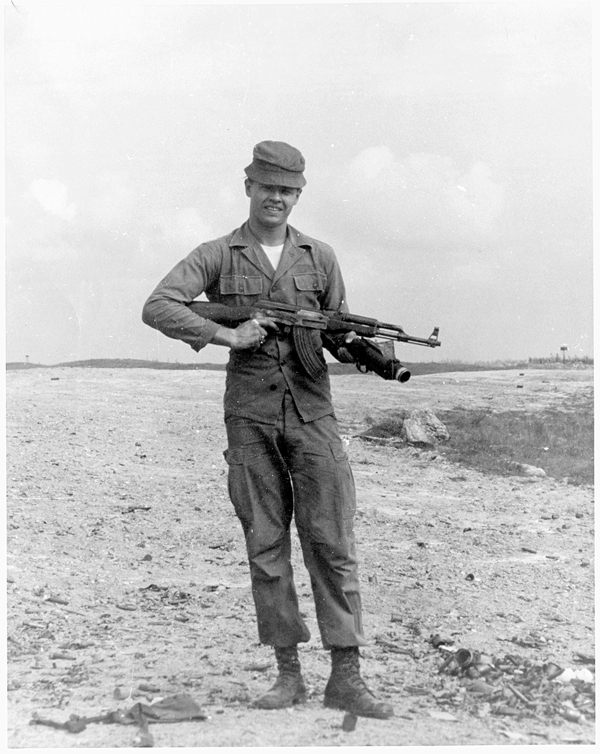
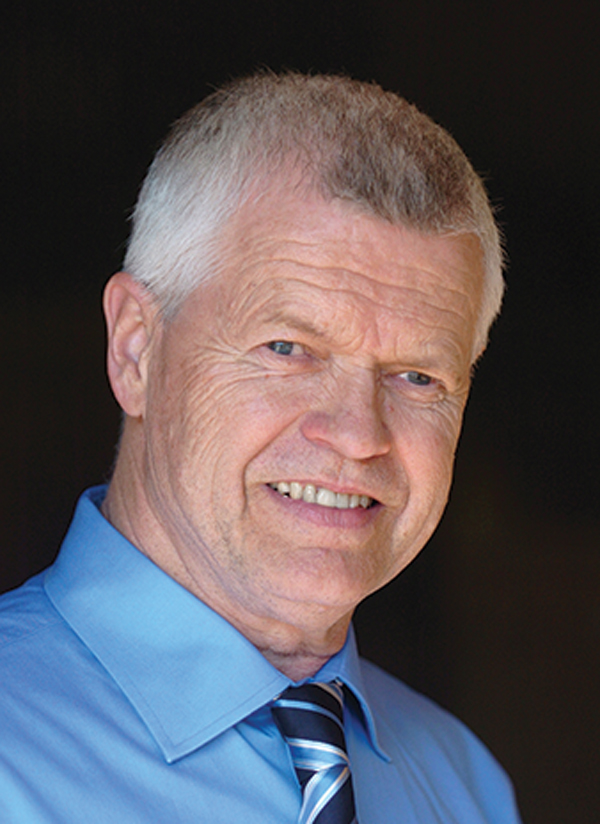
Leave A Comment